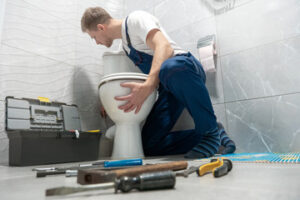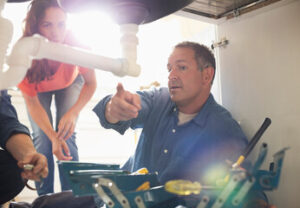Plumbing Provo is a system of pipes that transports water and sewage in buildings. It includes supply lines, drain lines, and appliances like sinks, toilets, showers, and water heaters. Plumbers use specialized tools and techniques to install, repair, and maintain these systems.

A good plumbing system is essential to our health and safety. It ensures clean drinking water and efficient waste management.
Residential plumbing systems are designed to deliver clean, fresh water to household fixtures and remove waste water efficiently. They include a network of pipes that carry water to toilets, showers, sinks, dishwashers, washing machines, and more. The system also includes a drainage line that transports wastewater to the sewer or septic tank. Keeping these systems in good working condition is essential for safe, clean living. A professional plumber can help you repair leaks, clogs, and other plumbing issues.
In a home, there are two basic plumbing systems: the water supply and drain-waste-vent system. The water supply system delivers municipal water to your house from the city water valve and water meter, then branches out to all the faucets, toilets, bathtubs, showers, and other household appliances that use water. The drain-waste-vent system carries waste water to the sewer or septic tank and prevents backflow from toilets and other fixtures.
While most people think of plumbing as a series of pipes, the system is actually much more complex. The water supply system must be able to handle high volumes of water under pressure while preventing rust and other contaminants. It must also be able to handle sudden water demand, like after a toilet flushes. The drain-waste-vent system must also be able to handle large volumes of wastewater and avoid blockages.
Understanding how a plumbing system works can help you identify and repair problems before they become serious. You can also save money by taking a proactive approach to your home’s plumbing needs.
There are a number of different types of plumbing materials, but the most common ones used in residential settings are PVC and copper. PVC is durable and cost-effective, while copper offers superior longevity and resistance to corrosion. For a more sustainable option, consider a greywater recycling system that uses rainwater to flush toilets and water plants.
A plumbing system is a vital part of any household, but it can be confusing to understand how it all works. With a little bit of knowledge, you can keep your plumbing system running smoothly and efficiently for years to come.
Plumbing fixtures
Plumbing fixtures are essential parts of the home and must be installed correctly to ensure a functioning system. They include faucets, sinks, toilets, showerheads, and bathtubs, as well as kitchen taps. The primary function of the plumbing system is to deliver potable water to different areas of the house and remove waste and wastewater. These fixtures must be able to withstand heavy use and the elements. For this reason, they should be made from durable materials, such as brass or porcelain. They should also be insulated to prevent the pipes from freezing in colder weather.
The most common type of plumbing fixture is a faucet. They come in a variety of styles and materials, and can be used to add a touch of elegance or functionality to the kitchen or bathroom. Choosing the right fixture for your space is important, and you should do your research to find one that fits your style and budget. A reputable design professional can help you examine a range of options and find the best fit for your needs.
Most plumbing fixtures have a drain that can be turned off to stop the flow of water. Some also have a “flood rim” level, which is the point at which water will overflow if it can’t be stopped. If you are looking for a more environmentally friendly option, consider a low-flow faucet that uses less water and energy.
There are many different types of plumbing fixtures, and each has its own unique function. For example, showerheads are designed to provide a stream of water at varying temperatures, while toilets are meant to flush and hold waste. Other fixtures include kitchen sinks and dishwashers, which are designed to handle large amounts of water. These appliances should be easy to clean and sanitary.
If you’re building a new home, it’s worth installing high-quality plumbing fixtures to get the most out of your investment. This will help you save money and keep your home running smoothly for years to come. In addition, upgrading your plumbing fixtures can increase the value of your home and make it easier to sell in a competitive market. It’s also important to maintain your plumbing fixtures properly by cleaning them regularly and scheduling regular inspections with a professional plumber.
Plumbing materials
Plumbing pipes transport water in and out of your house, connecting toilets, sinks, showers, washers, lawn sprinklers, and more. They must be able to withstand high volumes of pressurized water and a wide range of temperatures. The best pipes will last several decades with little maintenance. The pipes in your home are made from a variety of materials, including copper, PVC, and CPVC. Each pipe type has its own advantages and disadvantages, so you should choose a material that meets your needs.
The type of piping used in your house will largely depend on when it was built. An older home may have galvanized steel or cast iron pipes, while newer homes have a more diverse array of pipe types. Depending on your needs, you can find pipes that are fire-resistant, corrosion-resistant, or insulated.
Plastic piping is the most common type of plumbing in modern homes. It is lightweight, low-cost, and easy to install. It is also highly resistant to chemicals and will not react with corrosive substances or rust. The most commonly used type of plastic piping is polyvinyl chloride (PVC). PVC pipes look like hard, white plastic and usually have markings down the side that indicate their diameter.
Copper pipes are more expensive, but they are very durable and can withstand high water pressure and a wide range of temperatures. They have a reddish-brown sheen and can last upwards of 50 years. They are also highly corrosion-resistant and are the best choice for bringing potable water into your home.
Chlorinated Polyvinyl Chloride (CPVC) is a similar pipe to PVC, but it is chlorinated to increase its resistance to corrosive substances and rust. It is often used for hot water systems in homes because it can withstand high temperatures without warping or cracking.
Another popular type of piping is cross-linked polyethylene (PEX). This plastic piping is flexible, making it easier to install than traditional PVC pipes. PEX is also a good choice for homes with radiant heating systems. It is a relatively new plumbing material, but it is quickly becoming a favorite of plumbers and homeowners alike.
Plumbing regulations
Whether you’re remodeling your bathroom or installing a new dishwasher, you’ll need to follow the plumbing codes that regulate the design and installation of these systems. These codes include specifications for pipe sizing and pressure regulation. They also address issues such as backflow prevention, drainage and sewer systems, and water conservation. The code is updated frequently to reflect advances in technology and changing consumer demands.
Keeping up with these changes is important for homeowners. These changes can impact everything from the quality of your water to the safety of your home’s piping. The plumbing codes also determine the minimum requirements for new construction, additions, alterations, and repairs to plumbing systems. They are designed to ensure the health, safety, and welfare of building occupants.
Plumbing codes and regulations govern the construction of residential and commercial plumbing systems. These codes set standards for water supply and distribution, sanitary drainage and wastewater management, fixtures and faucets, venting systems, and plumbing equipment and appurtenances. They also cover the requirements for fire protection and emergency systems. These codes are enforced by local governments and are part of the International Code Council’s family of model codes.
The National Uniform Plumbing Code (NSPC) is a set of standard plumbing rules that governs the construction and repair of residential, commercial and industrial buildings. It is a model code that was developed by the PHCC and adopted by the International Code Council on a state or local level. The NSPC includes requirements for water supply and distribution, sanitary drainage, plumbing fixtures and drains, waste disposal, water heating and appliances, and ventilation systems.
Some piping is located in concealed locations, such as inside walls and ceilings. These pipes must be protected by shield plates to prevent leaks and corrosion. The shield plates should be a minimum of 0.062-inch thick and extend a minimum of 2 inches above and below the exposed end of the pipe. In addition, piping must be supported at changes in direction and at supports.
